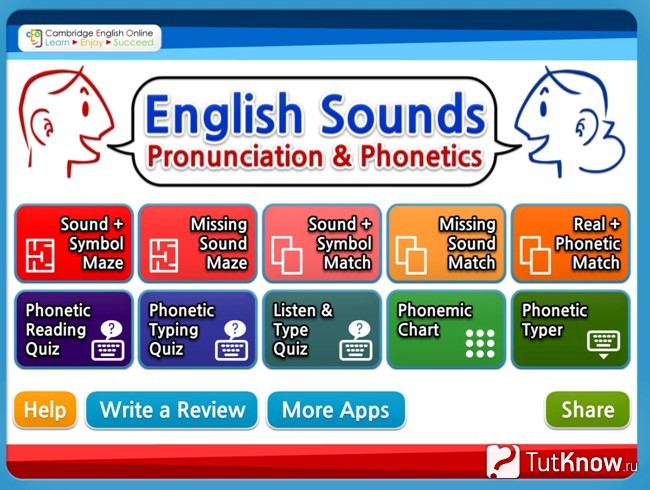Pronunciation often becomes a problem for those who take up learning a foreign language. We talk about how to improve it yourself in our article.

Perhaps the conversation should start with the right motivation. If your list of goals for working on pronunciation sounds like “I want good English pronunciation,” this is completely wrong. Choose concrete example, for example, “I want to speak English like Matthew McConaughey.”
The timing of the implementation of the plan also requires specification. A goal that has no time limits for execution remains just a goal. Choose a specific date for yourself, sensibly assessing your capabilities and the amount of time that you can devote to English every day.
You should have at least five “whys” that will shape your motivation. Arm yourself with a piece of paper and a pen and write down all the benefits of good pronunciation. In your list, you can safely include items about a well-paid job, personal acquaintances, travel, or maybe you plan to pack stadiums and perform songs in English.
Time to act - methods for working on pronunciation

Having carried out small motivating preparatory work, you can begin to take immediate action. We offer you the most effective exercises.
- If you are a film buff, purchase your favorite films in the original (in English), but if you prefer to sing, opt for high-quality audio recordings. Play small scenes from films, paying attention to English subtitles and the intonation of the characters. In the case of an audio track, print out the lyrics and follow the same principle. Rewind one sentence, repeat it verbatim at least 10 times. Your “solo performance” should be clear, loud and intelligible, respecting the intonation and rhythms of speech. For total immersion You can also copy your idol’s gestures into the image. Such exercises should be completed daily for at least 30 minutes.
- The next mandatory item is verification. You should not get carried away with this method; it is carried out 1-2 times a month. Play the scene and record it on a voice recorder. Listen and compare how different the result is from the original. Well, have you already reminded yourself of Matthew McConaughey?
- Your obligatory companions in working on pronunciation should be exercises to form the correct accent. By the way, it is precisely this that reveals the fact that the language is not native to you, no matter how well you juggle complex vocabulary. Stress in English (and not only) languages can be verbal or phrasal. The first in most cases does not cause difficulties, which cannot be said about the second category. When listening to texts (namely, listening, not reading), pay attention to the stressed word. Not only the pronunciation, but in some cases the meaning of what is said depends on the correctness of its definition. You can get acquainted with the theoretical foundations of phrasal stress with the help of books, which we will discuss below.
- If the very concept of transcription disheartens you, replace it with a Color vowel chart. The latter is a table in which each vowel sound is assigned a specific color. Believe me, a colorful dictionary will make learning more interesting than a ton of fancy transcription icons.
- The rhythm of the language is perfectly trained with the help of poems and tongue twisters. The advantage of such small exercises is that they do not require you to understand the vocabulary and are easily remembered thanks to the rhyme.
Choosing textbooks

We can sing along to Cher for a long time and intensely or copy DiCaprio's speech, but none of this will make sense without a minimum theoretical basis. Namely, for this we need a high-quality phonetic textbook.
- Jonathan Marks, Sylvie Donna "English Pronunciation in Use". It can rightly be called one of the most popular sources for studying the peculiarities of English phonetics. An excellent bonus to the book is the presence of audio materials.
- Ann Barker "Ship or Sheep" and "Tree or Three". The books have an identical structure, but are designed for students of different levels. “Ship or Sheep” is suitable for those who have already reached the Intermediate level. Ann Barker's brainchild differs from all other books in its comprehensive approach; here you can work with audio recordings, phonetic dictations, and a lot of exercises based on dialogues.
- Bill Bowler "Timesaver Pronunciation Activities." It will be appreciated by those who are looking for a non-standard approach to teaching a foreign language. Instead of boring rules and explanations, you will find exciting quizzes, games and a variety of crossword puzzles. Suitable even for those who have just started studying English language.
- Colin Mortimer's Elements of Pronunciation is designed for more advanced levels, diving into more complex phonetic aspects and covering the most common mistakes. The best source for practicing intonation and stress.
- Peter Watchyn-Jones “Test Your Pronunciation” cannot be called a full-fledged textbook, since the book is a collection of exercises and tests that are recommended to be taken between theoretical lessons.
Keep up with the times: apps for working on pronunciation

It would be a real crime not to use all the know-how that has been carefully developed for our gadgets. So, TOP 5 applications for working on pronunciation.
- Sounds: The Pronunciation App. The application was developed by the authors of Macmillan publishing house, who certainly know a lot about an integrated approach to studying foreign languages. The application is presented in the form of a phonemic interactive table of the British and American versions of the language. “How do you say” is a fairly useful option that allows you not only to listen to individual words, but also to record what you say yourself. For an additional fee, you can purchase more extended word lists. Available for iPod Touch, iPhone and Android owners.
- No less popular is the English File Pronunciation application, which was developed under the strict guidance of Oxford University Press. Like Macmillan, English File Pronunciation allows you to choose between the American and British versions of the language. In the limited free demo, you get access to audio interactive chat, a 500-word dictionary, and the ability to record spoken words. Available for iPhone, Android, iPad and iPod Touch.
- Rounding out the top three is Pronunciation: Clear Speech, developed by Cambridge University Press. The application will appeal to children, as well as those who do not like monotonous routine pronunciations. All work is based on the principles of the game. Recommended for a level not lower than Intermediate; for pre-intermediate, a version of Basic Pronunciation: Clear Speech from the Start has been developed.
- Howjsay English Pronunciation is created in the form of a dictionary, downloaded from iTunes or PlayMarket, and contains more than 150 thousand words and phrases of the active American and British language. Unlike the previous ones, it requires access to the World Wide Web.
- Pronunciation King is developed in two versions (American and British), downloaded from the Play Store and does not require constant access to the Internet.
About the role of songs in learning English, watch this video:
) a very interesting discussion took place. In mine, like Peirce, I start from differences in the basic speech position, or, as Peirce calls it, the “initial articulatory setting.” Naturally, we have different perspectives on this issue. I proceed from the idea of the Russian basic position of the language and say that in English speech the tongue is pressed down and forward. From Peirce's point of view, the tongue is pulled back. There is actually no contradiction in this, as will become clear below. Moreover, everyone clarified for themselves in what terms it is better to describe the position of the tongue, and, most importantly, during the discussion I made a couple of discoveries for myself, which I will now share.
So, work on pronunciation must begin by developing a new initial articulatory position. So far, this has not raised any objections from anyone, and more than a thousand people have already signed up for the pronunciation course, for example. But there are still two problems here.
- My description of the position of the tongue, as it was stated, is still subjective. If I myself follow this description literally, then the final position does not always seem to me as comfortable as possible. This means clarification is required.
Description is good, but you need an exercise that would be guaranteed to bring the tongue into the desired position and consolidate this position as a skill.
It's time to deal with both of these problems!
In the Russian position, the back of the tongue (middle and root) is raised upward. Therefore, on the sounds “n”, “t”, “d”, etc. the tip of the tongue naturally presses its upper side against the palate. In the English speech position, the tongue barely reaches the palate and therefore touches it with its butt. That is, the front part of the tongue is pulled back. It is impossible to retract your tongue completely (try it yourself). How does it happen that the end of the tongue in the English position is pulled back?
The trick is that the tongue is a muscular hydrostat, and its main property is its constant volume. Thus, by increasing the volume of the back of the tongue, we take away volume from the front, which causes the tip of the tongue to retract. “That's good, Owl, but how can we increase the volume of the back of the tongue?” By flattening and stretching it to the sides! Try to imagine that you are smiling with the root of your tongue without stretching your lips.
This flattening is exactly what I mean by pressing the tongue down and forward from the usual suspended position of the tongue. Please note: we are talking exclusively about the back of the tongue, i.e. In this case, the tip of the tongue in no case extends, but, on the contrary, retracts back due to a decrease in volume.
Now let's talk about how to make sure you're doing everything right. First, say the phrase “tea for two” (/tiː fə tuː/) and listen to how it sounds to you. Repeat it again, but this time make sure that on /t/ the tip of the tongue touches the roof of the mouth, not the top. If your tongue remains in the Russian weighted position, then your /t/ will have a “ch” sound. This is a sign that your tongue is pushed too far forward. How to deal with this? With the following simple exercise.
Your task is to stretch back tongue to the sides, bite it on the sides with molars (molars). Don't push your tongue forward! That's all the exercise. Just try to keep your tongue between your teeth confident and didn't slip out. The tip of your tongue remains free! Now, with your tongue bitten on the sides, say “tea for two” again and “feel the difference.”
The picture is for clarity. Not Bryullov, of course, but what they are rich in, as they say.
And to answer a possible question - no, you won’t have to bite your tongue for the rest of your life. Eventually you will develop this skill of stretching the back of your tongue out to the sides. Then the molars will act as reference points - you will only need to either stick the sides of your tongue between them, or, ideally, even just rest against them.
Let’s not hide that teachers devote little time to pronunciation exercises in class, they say, they would have time to explain grammar, give vocabulary, and pronunciation will improve itself, you just need to listen and speak more. This approach is partly justified: pronunciation actually improves if you listen and pronounce often English speech. But, nevertheless, there are special techniques that will make working on pronunciation even more effective. After all correct pronunciation- it’s not only beautiful, it often depends on it whether our speech will be understood or not, and this is a matter of principle.
1. Exercise on stress.
Have you noticed that a native speaker can be distinguished very simply by intonation. Natives speak with a special intonation that is difficult to reproduce for those for whom English is not their native language.
Intonation is the tone, rhythm of speech and stress. Stress can be verbal or phrasal. If everything is more or less clear with verbal stress, it can be clarified in the dictionary, then learning to determine phrasal stress (which word is stressed in a sentence) is very important.
For example, take two sentences: “Do you know is that Mr Fough?” and “Do you know is that mist of fog?” Try saying each of these sentences quickly. The only thing that will help you make them different from each other is phrasal stress.
When listening and reading texts, pay attention to which word is stressed in the phrase, this will help you develop the habit of speaking with the correct intonation.
Example table from the US government website
2. Color the sounds
Color vowel chart - a table in which the vowel sounds of the English language are associated with a specific color. Instead of boring and faceless transcriptions, you can use colors! Take this into account, it really works. And on the Internet you can find online resources that allow you to get the maximum benefit from the table.
3. Poems to help
Rhymes and poems are a great way to train the rhythm of the language, and therefore improve pronunciation. Rhymes are easy to remember, fun to learn, and even more fun to read to friends or to yourself.
Here is one of Carolyn Graham's rhymes that help you learn language structures in their natural rhythm, intonation and speed and with almost no effort:
If it rains/ I’ll wear my raincoat,
If it doesn't rain/ I won't
When it's cold / I always wear my gloves,
When it isn’t cold/ I don’t.
If it snows I won’t wear sandals.
If the sun comes out I will.
But if it rains I’ll wear my brand new coat.
If I don’t I’ll get a chill.
4. Watch your tone!
In English pronunciation, alternating three tones of voice is important: low, medium and high. How does this happen?
If you utter an affirmative sentence, instruction or request, and also ask a general question, then the tone alternation is: medium, high, low. That is, you start a sentence with a middle tone, then raise it, and at the end of the sentence the intonation goes down.
Try saying the following sentences using this pattern:
He studies French.
Bring me the papers.
Why is she absent?
And if you ask a question that can only be answered yes or no, then the tone is first medium and at the end high: Did you see him?
And finally, when working on pronunciation, remember the rule: “Trust your ears, not your eyes.”



